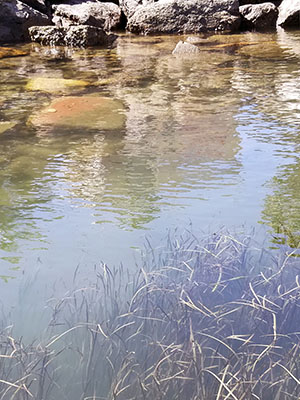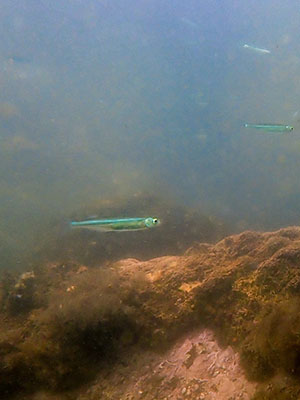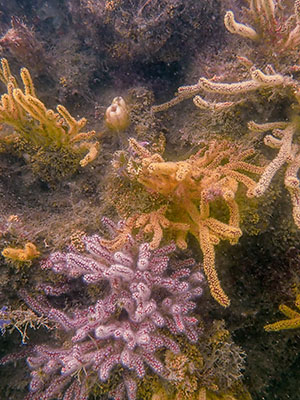
Cabrillo Marinas and Cabrillo Beach

You Are Here
Whether you’re looking to enjoy an afternoon at the beach, hop aboard a fishing or whale watching boat, or enjoy a walk along the water, the Cabrillo area marinas and Cabrillo Beach are ideal locations to get up close to marine habitats and wildlife in the outer harbor.
On this Page:

Habitats Located at
Cabrillo Marinas and Cabrillo Beach
Cabrillo Beach is located in the outer harbor and is part of a series of shallow-water habitat areas that have been created as a way to offset development elsewhere in the harbor. Habitats in these shallow areas include eelgrass, open
water and riprap embankments. The adjacent Cabrillo Marinas are large, active recreational boating facility.
Hover over the images below to learn more about the different habitats located at Cabrillo Marinas and Cabrillo Beach.

Seafloor
The seafloor in this area supports large eelgrass beds, with approximately 25% of the eelgrass in the Port of Los Angeles located near Cabrillo Beach. This area is highly productive and promotes high diversity of in the fish and invertebrate communities. Common animals include amphipods and shrimp and other tiny invertebrates that cling to the blades of eelgrass, snails and lobsters that roam looking for food, and small fishes that can hide in the eelgrass beds to avoid predators like larger fish, sea ...
Learn more!
Pelagic
The open water areas in the outer harbor are productive for schooling bait fishes such as anchovies, topsmelt, and grunion. This makes these areas valuable foraging grounds for marine mammals like sea lions and harbor seals as well as birds like terns, grebes, and cormorants. During the spring, outer harbor areas can also be visited by migratory gray whales and their calves as they make their way north from their birthing grounds in the Gulf of Mexico.
Learn More
Riprap
Riprap embankments protecting the shorelines of the outer harbor provide crevices and caves for animals to hide in as well as substrate for algae and animals to attach to. Common animals found in this habitat include scallops, soft corals, lobsters, and macroalgae including coralline red algae and giant kelp.
Learn MoreWhat Lives Here?
Eelgrass and shallow, sandy seafloor provide extensive habitat for juvenile fishes like bass, flatfish (like halibut and turbot) as well as invertebrates such as shrimp, crabs, and lobsters. The sandy beaches also attract pelagic fishes
such as grunion, which make an annual ‘run’ during a full moon to swim up onto the beach to deposit their eggs in the sand.
Check out the pictures below to see examples of species that have been found near Cabrillo Marinas and Cabrillo Beach!
Riprap, Pilings and Seafloor in the Outer Harbor
The outer harbor is a diverse mix of underwater pilings and riprap surrounded by sandy seafloor that can support kelp, eelgrass, and a wide variety of animals and algae. Check out some of the animals that inhabit this area of the harbor!
Test Your Knowledge!
How much do you know about Harbor Food Webs?
How does energy flow through the harbor food webs? Play our game to find out!
Drag the animals (in the gray boxes) to their correct place on the food web!
Click “check” at the bottom to check your answers.











